< Previous | Contents | Next >
The Gipsy King
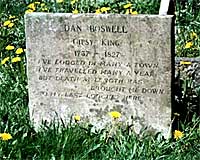
Dan Boswell's restored gravestone.
SELSTON. The finest views of this colliery village are from the neatly tended churchyard, with lovely trees, where we look out to the Derbyshire hills and Crich Tower high in the west. It is a fitting resting-place for one who loved the open country, and under the shade of a lofty lime near the 15th century tower lies Dan Boswell, King of the Gipsies. On the broken stone now flat on his grave a few words are still seen, and though the epitaph is gone it was odd enough to be remembered:
I've lodged in many a town,
I've travelled many a year,
But death at length has brought me down
To my last lodging here.
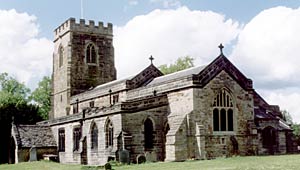
Selston church in 2003.
The church is old and beautiful. The entrance archway of the porch has capitals carved with grotesque faces, some with foliage coming from their mouths; it is about 1200. The splendid south doorway has a round arch on shafts with rows, of ornament between them. The round arches and pillars of a Norman arcade divide the nave and north aisle; the south arcade, the plain chancel arch, and the arcades between the chancel and its chapels, come from the first years of the English style.
The clerestory and the east window are 15th century, and a pretty recessed window in the chancel comes from the end of the 13th. The effect of the lofty tower arch framing the old west window, glowing richly with modern figures of Our Lord, Nathaniel, and Philip, is charming. St George and the Dragon in a small window is in memory of nearly 50 men who died for peace.
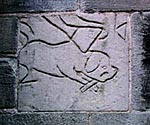
Carving of dog gnawing a bone (2003).
In the bright Children's Corner is the bowl of the Norman font which came back to church in 1900 after being a trough at one of the inns. On an ancient floorstone is the crude figure of a priest holding a chalice. A great stone in the tower has a rare cross, and in an outside wall is a stone engraved with a dog gnawing a bone. A little old work is left in the roofs, and among the quaint stone heads supporting the beams in the nave are a man and a woman like Darby and Joan. The oak pulpit, with rich vine borders, is of our century.
On an alabaster monument lie the great figures of William Willoughby and his wife, he a young knight in 17th century armour, his face worn away; she in a gown with pointed bodice and full skirt, long sleeves puffed at the elbow, and ruffs at her wrists. An inscription has their names, and high up on the wall is a tablet with the original epitaph, on which are the words, "yet left ere he went a pair of female babes besides his infant heir, a hopeful imp, a right young Willoughby."
A landmark in this colliery countryside is the 50-year-old stone church at Underwood (two miles away), a shingled spire crowning the tower.
The Pride of the Stanhopes
SHELFORD. Delightful is Shelford when seen from the Malkin Hills which bring us from Radcliffe-on-Trent. With its houses and farms clustered round the old grey church, in a luxuriant patchwork of pasture and ploughland and winding river, Nottinghamshire has few prettier or more typical scenes to show us. So peacefully does it lie off the beaten track that it is hard to realise that one chapter of its long story fills one of the blackest pages in the tale of the Civil War, when the night sky was all aglow with the burning of the home of the Stanhopes.
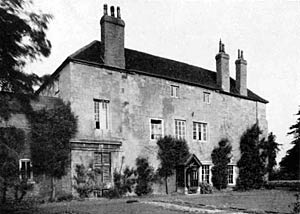
Shelford Manor in the 1930s.
They came to the village when Henry the Eighth granted to Sir Michael Stanhope the small 12th century priory, and here they lived for about a hundred years, pulling down the priory and building a manor house. It was an eventful century in the story of the Stanhopes, who were one day to have three earldoms.
Sir Michael was brought to the block for loyalty to Protector Somerset. His grandson Philip paid James the First £10,000 for a barony, and in 1628 Charles Stuart made him Earl of Chesterfield. After being captured by the Roundheads and buying his ransom early in the Civil War, he retired from the struggle and left his son to fight for the king. Philip Stanhope, his fifth son, fortified Shelford House which, with the garrison at Wiverton Hall, was for a long time a source of harassment to Nottingham Castle under Colonel Hutchinson, hindering transport both by road and river.
In 1645 the Parliamentarians determined to reduce Shelford and Wiverton before the final siege of Newark, and offered Colonel Stanhope favourable terms to surrender. After a scornful refusal, in which Philip Stanhope threatened to "lay Nottingham Castle as flat as a pancake," General Poyntz with Colonel Hutchinson and Colonel Rossiter set out to capture the stronghold, and the first thing they did was to burn out a party of Shelford snipers who were lodged in the church tower, having drawn up the ladder and the bellropes and taken a small cannon to the top with them. Colonel Stanhope refused the summons to surrender in these words:
Sir, I keep this garrison for the king, and in defence of it I will live and die, and your number is not so great, nor you so much master of the field, but that I am confident soon to lessen your number and see you abroad; and, for relief, we need none. Therefore I desire you to be satisfied with this answer from
Your servant Phil. Stanhope.
The order was given to storm the stronghold. After a gallant defence Colonel Stanhope was mortally wounded, about 140 of the Royalists were slain, and the rest were taken prisoners. The manor house was set on fire that night, and a small part of it which survived is in the house we see.
Many Stanhopes lie in the church, and their monuments, with a funeral helm and a gauntlet, are now in an aisle enclosed by a screen made from the timbers of the old roof. There is an inscription to Sir Michael who lost his head on Tower Hill, and a tomb with the alabaster figure of his wife. Three of their children round the tomb are in swaddling clothes.
The church is rich in fame. The famous 4th Earl of Chesterfield was brought to rest here after being buried first in London, and is mentioned on a tablet. Statesman and wit, he will ever be remembered for the letter his belated patronage called forth from Dr Johnson after the publication of his Dictionary beginning:
Seven years, my lord, have now passed since I waited in your outward rooms and was repulsed from your door.
A wall monument by Chantrey, showing the graceful figure of a woman, is to Lady Georgiana West, who died in 1824 at 22. Another of the Stanhopes was Eliza Ellis, wife of Welbore Ellis who became the first Baron Mendip and wrote her praise in her epitaph here, ending with the lines:
Such my Eliza was, and shall no verse
Record these virtues or adorn her hearse?
Forbid it Justice, Gratitude, and Shame,
He who best knows attests it with his name.
A story is told of the village tailor here who early last century must have thought there was no harm in robbing the dead to clothe the living. For a long time he was supplying customers with waistcoats of rich red velvet at a very moderate price, and there seemed to be no end to his supply of beautiful material. But the truth came out when someone saw the connection between the fact that he was sexton as well as tailor. Having access to the vaults, he had been stripping the coffins of the Stanhopes of their handsome funeral trappings to make waistcoats for his customers!
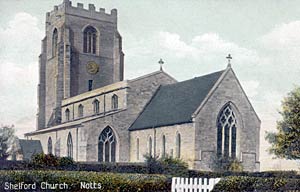
Shelford church, c.1905.
Much of the beautiful church is 14th century, but the tower which had such a dramatic share in the Civil War, and the clerestory above the lofty nave arcades, are 15th. The chancel has lovely modern glass of the Crucifixion with Peter and Paul in the new east window, and the Four Evangelists in four old lancets. In a beautiful window in' the north aisle the Wise Men are bringing gifts to the Holy Child.
Older than anything else here is a fine fragment of a Saxon cross on a window-sill; nearly three feet high, it is carved on one side with the Madonna and Child, the Babe without a halo and holding what seems to be a scroll; on the other side is a winged angel, and knotwork adorns the edges. A chest is 16th century, the font 17th.
Two storied possessions the church has belonging to our own day. One is an oak angel holding a wreath above an inscription to a farmer of Whatton who, hearing the cry of a boy who had fallen into the River Smite when in flood, rushed to his help and was drowned through the river bank giving way. He was William Lamin. The other is a wooden cross with a metal Crucifix. For long it was an odd piece of wood lying in the churchyard, till a stranger one day asked the vicar if he might have it. He took it away with him, and the vicar was delighted to have it returned to him a few months later in the shape of this lovely cross, carved by a master of his craft. The vicar who showed it us with pride when completing his 50 years here in 1932 was still here when we called again in 1938.
The Letter-Bag of Lord Chesterfield
HOW quiet, how remote, is the resting-place of the notorious Lord Chesterfield! During the closing days of his long life (1694-1773) Philip Dormer Stanhope, 4th Earl of Chesterfield, asked how he fared, answered that he had been dead two years but did not choose to have it known. Dead to fame he will never be, to a fame based on shining qualities of intellect marred by heartless cynicism, with the worship of social graces and the accomplishments of the polished rake. Two things make him memorable to posterity, the letters he wrote and a letter he received, the hundreds of shameless letters to his son, and the letter addressed to him by Dr Johnson. Was ever such a letter-bag as his!
The Chesterfield Letters, brilliant, scandalous, immoral, are overcast by the shadow of tragedy. Their author hoped to make his son the perfect man of the world, master of guile, of social deceit, of every art conducive to worldly success which was not incompatible with a veneer of dignity and conventional breeding. The son was incapable of absorbing his lessons. He wilted under the blazing lustre of his father's overpowering counsel. He married secretly, died prematurely, and left an impecunious widow who, to Chesterfield's dismay, published the letters soon after her husband's death.
Dr Johnson's letter to Chesterfield was the result of the nobleman's neglect to help him while he was struggling with poverty during the preparation of his Dictionary. It is perhaps the most famous letter in our language.
